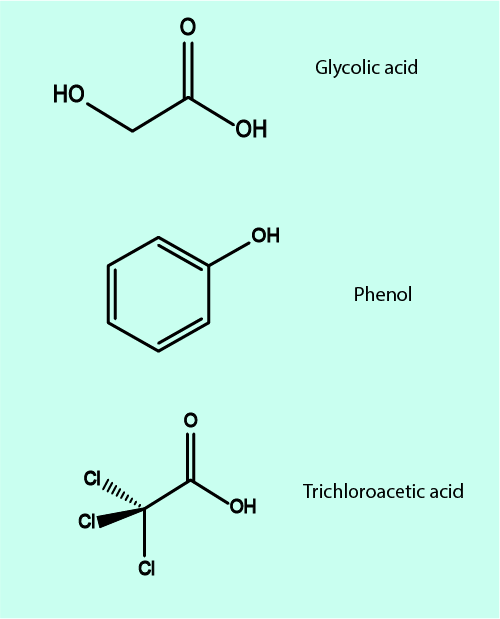Peeling
Procedures referred to as ‘facial rejuvenation’, ‘chemical peeling’, facial resurfacing’, or ‘non-surgical facelift’ destroy the very superficial layers of the skin. After healing finer rhytids (wrinkles), scars and pigmented spots will be much reduced or disappear, thus resulting in an improved appearance of facial skin. Accordingly, the most common reasons to perform such procedures are aged skin (chronic photo-ageing), hyperpigmentation and scarring from severe acne. Facial resurfacing has also been reported as a means to improve the aesthetic appearance of facial skin grafts and free flaps.
Chemical agents used in these procedures (‘chemical peeling’) essentially dissolve and remove damaged skin and initiate wound healing which, in turn, leads to skin rejuvenation. The effect is achieved because these chemical exfoliating agents cause denaturation of proteins in the epidermis (the outer layer of skin) and dermis (the layer underneath the epidermis). This triggers inflammation and induces the healing process.
Different chemical agents (Figure 1) affect the skin to different depths.

These agents are usually classified according to the depth of lesion they cause. The usual categories are superficial, medium-depth and deep peels. The effect depends not only on the type of chemical, but also on its concentration, duration of application, repeat patterns of treatments, and individual skin type.
Superficial peels only affect the epidermis. Glycolic acid (Figure 1 top) and several similar chemicals agents in dilute preparations are typical for these applications. As only the epidermis is affected, superficial peels have no effect on wrinkles.
Medium-depth peels penetrate the epidermis and parts of the dermis; trichloroacetic acid (Figure 1 bottom) is an example of a chemical agent used to achieve medium-depth peeling. Trichloroacetic acid is used to treat fine rhytids, hyperpigmentation, and occasionally UV-radiation (photodamage) related, premalignant skin lesions such as actinic keratosis. Application of higher concentrations of trichloroacetic acid carries a significant risk of adverse effects, including scarring, alteration of skin colour, bacterial superinfections and reactivation of herpes simplex infection. Medium-depth peels are painful during and after the procedure and typically require pain control with nonsteroidal anti-inflammatory agents (NSAIDS).
Deep peels reach all levels of the epidermis and dermis, and sometimes accidentally even deeper tissue layers. Deep peels can address more severe rhytids, photo- and age-related damage, and hyperpigmentation. The classic agent to perform chemical medium-depth to deep peels was phenol (Figure 1 middle), later typically used in preparations containing phenol, water, a detergent and croton oil (where it was eventually shown that the active peeling agent in this preparation is the croton oil, a poisonous substance isolated from a plant belonging to the euphorbia family). Phenol is a toxic substance and is to some extent systemically absorbed during treatment exposure. Phenol has adverse effects on the cardiac system and is toxic to liver and kidneys. Deep peels are painful during and after the intervention and require more potent analgesia. After treatment, severe inflammation and facial swelling is likely to occur; initial recovery is likely to take at least two to three weeks. In addition to the systemic toxicity of phenol, there are significant risks associated with deep peels, similar to medium-depth peels. Infection risks seem to be associated with the depth of a peel intervention.
With these adverse effects in mind, it is not surprising that chemical deep peels have become less popular recently. A variety of lasers are widely available and can be used for controlled and precise ablation of skin layers by vaporisation, without systemic toxicities.
Similarly, mechanical dermabrasion techniques are commonly used to treat severe acne scarring and rhinophyma.